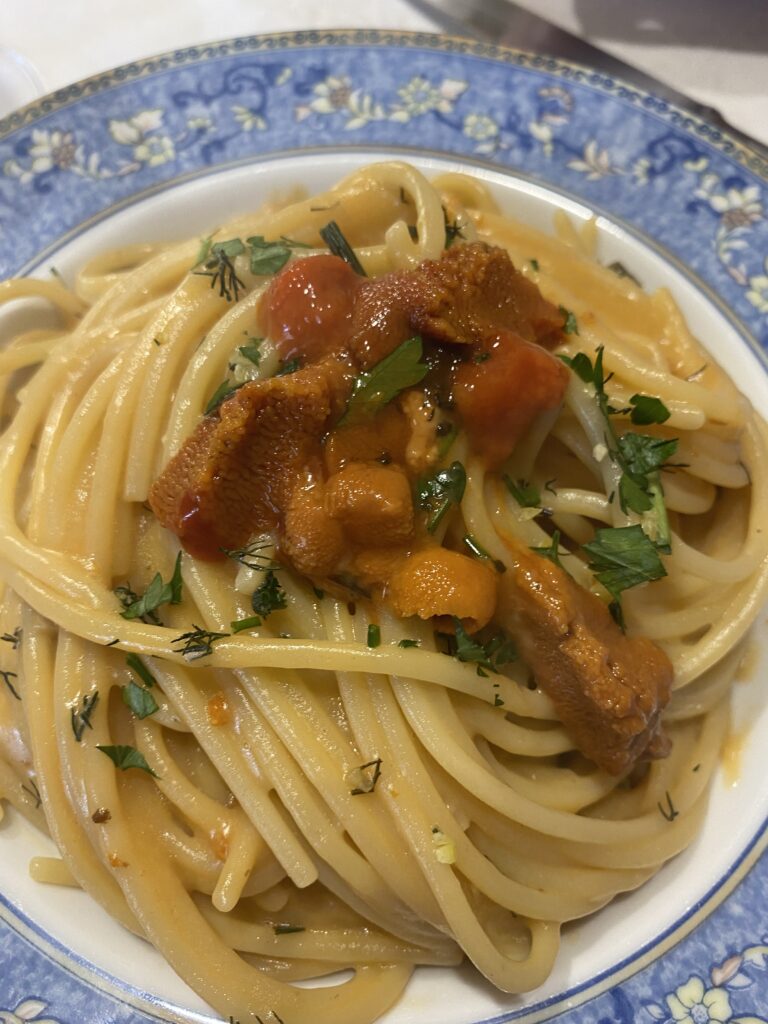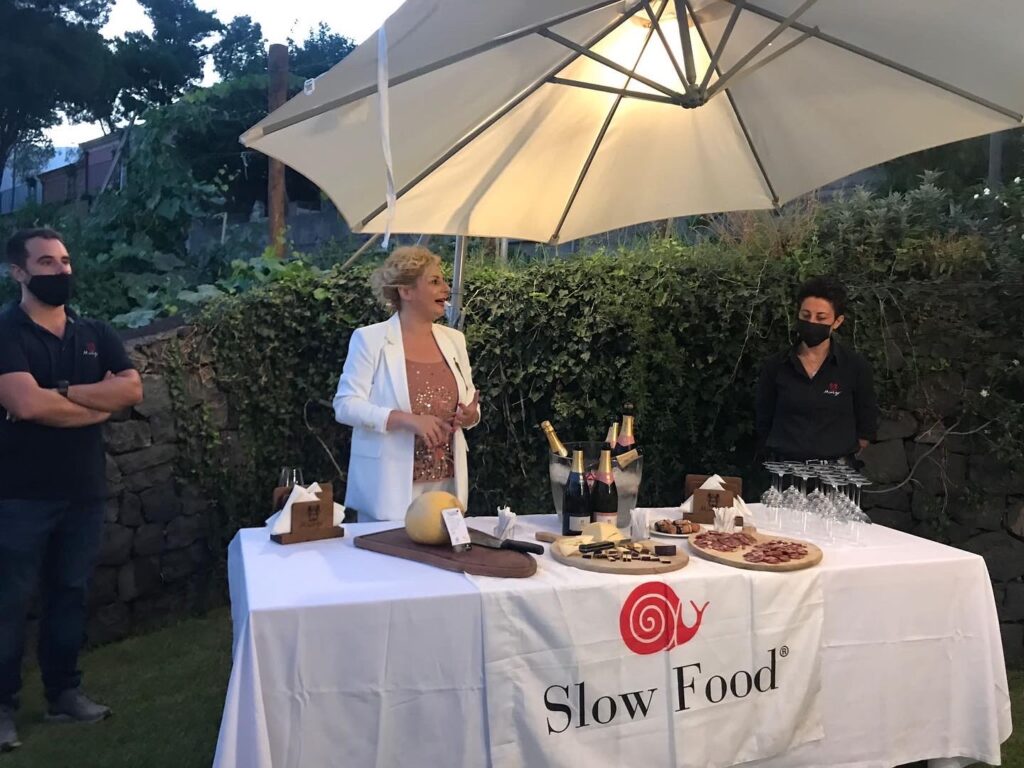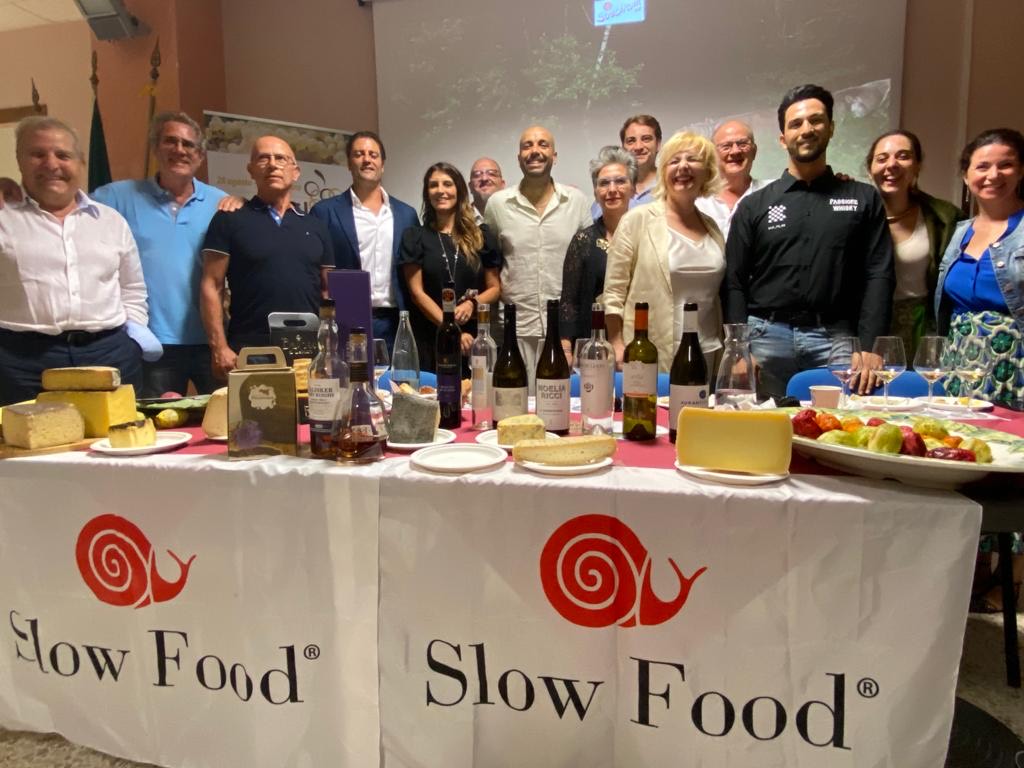╔
La cucina catanese tra tradizione e sostenibilità
Catania è stretta nell’abbraccio tra la montagna e il mare ed è in questo spazio che si trova il solco della sua opulenta e istrionica cucina.
La biodiversità che rende unico ogni luogo fa dell’areale catanese una terra privilegiata dalla quale attingere prodotti, profumi e sapori per assaporare la diversità delle stagioni anche nel piatto.
Dalle nocciole, alle antiche mele dell’Etna, al pistacchio verde di Bronte, alla fragolina di Maletto, al cavolo “Trunzo” di Aci.
Ogni prodotto che nasce e viene coltivato sull’Etna contribuisce a rendere unico quello che invece arriva dal mare incontrandosi in un connubio autentico e sempre diverso a seconda delle stagioni. E così l’iconica pasta alla catanese, capolavoro che mette insieme, armoniosamente, le sarde, il finocchietto selvatico, la passata di pomodoro, ci racconta come da ingredienti poveri e un tempo semplici da reperire, possa venire fuori un piatto straordinario e alla portata dei più.
Ricchissimo è il “Libro delle ricette” della cucina tipica di Catania che affonda le sue radici nella cultura popolare e che ha la presunzione di replicare i piatti più sofisticati della cucina dei Monsù [1], e che soprattutto ci ricorda la resilienza e l’ingegno del nostro popolo. Le sarde a beccafico; la pasta con il nero delle seppie; gli involtini di pesce spada, il tonno in crosta di pistacchio.
Sostenibilità e creatività caratterizzano la cucina di mare a Catania con una sempre maggiore attenzione alla stagionalità.
Catania is nestled in the embrace between the mountains and the sea and it is in this space that the furrow of its opulent and histrionic cuisine lies.
The biodiversity that makes each place unique makes the Catania area a privileged land from which to draw products, fragrances and knowledge to savor the diversity of the seasons also on the plate.
From hazelnuts, to the ancient apples of Etna, to the green pistachio of Bronte, to the strawberry of Maletto, to the “Trunzo” cabbage of Aci.
Every product that is born and cultivated on Etna contributes to making unique the one that instead arrives from the sea, meeting in an authentic and always different combination according to the seasons. And so the iconic “Pasta alla catanese”, a masterpiece that harmoniously brings together sardines, wild fennel and tomato sauce, tells us how poor ingredients that were once simple to find can produce an extraordinary dish that is affordable for most people.
The “Libro delle Ricette” of Catania’s typical cuisine is extremely rich, rooted in popular culture and presuming to replicate the most sophisticated dishes of the Monsù [1] cuisine, reminding us above all of the resilience and ingenuity of our people. Sarde a beccafico (stuffed sardines), pasta con il nero delle seppie (pasta with squid ink), involtini di pesce spada (swordfish rolls), tonno in crosta di pistacchio (tuna crusted with pistachio). Sustainability and creativity characterize Catania’s seafood cuisine with increasing attention to seasonality.
Alcuni piatti della tradizione gastronomica di Catania, in particolare la “Pasta alla catanese”. (Fotografia: Anastasia De Luca).
Some dishes of the Catania gastronomic tradition, the “Pasta alla catanese” in particular. (Photo: Anastasia De Luca).


E se negli anni 80 tutti noi avevamo dimenticato, in una smania di modernità, quali fossero le nostre radici, negli ultimi 20 anni, anche grazie a movimenti come quello di Slow Food [2], è cresciuta la consapevolezza nella nostra città della valorizzazione del territorio e delle peculiarità ad esso connesse, restituendo al cibo la dimensione di socialità che da sempre lo caratterizza, educando i consumatori ad un uso sostenibile e stagionale di tutti i prodotti, siano essi di terra o di mare.
Slow Food è, infatti, una associazione internazionale senza scopo di lucro che si propone di curare e valorizzare il territorio, l’ambiente, le professioni e la cultura delle nostre radici affinché il tempo non li sbiadiscano.
And if in the 1980s we all forgot, in a frenzy of modernity, what our roots were, in the last 20 years, also thanks to movements like Slow Food [2], awareness has grown in our city of the valorization of the territory and its connected peculiarities, restoring to food the dimension of sociality that has always characterized it, educating consumers to a sustainable and seasonal use of all products, whether from land or sea. Slow Food is, in fact, an international non-profit association that aims to care for and enhance the territory, the environment, professions, and the culture of our roots so that time does not fade them.
Una delle iniziative della sezione Slow Food di Catania per valorizzare i prodotti locali e promuovere la cultura del cibo. (Fotografia: Anastasia De Luca).
One of the initiatives of Slow Food section of Catania to enhances local products and promotes food culture. (Photo: Anastasia De Luca).

Nata in Piemonte oltre quarant’anni fa ad opera di Carlo Petrini, negli anni, questa associazione, è diventata il simbolo della lotta contro ogni forma di distruzione di tutto quello che è delle nostre radici e che attraverso il cibo viene raccontato e perseverato.
Da associazione di persone amanti del buon cibo e del buon bere con il tempo Slow food è diventata un’associazione che, partendo dal cibo buono pulito e giusto, parla di valori più alti come i diritti, i cambiamenti climatici. L’agroecologia è tutto ciò che mette insieme le nostre radici, la nostra storia e la nostra cultura. Tra i molti progetti di questa associazione vi è quello dei presìdi che sono piccole produzioni di qualità coltivate con metodi tradizionali che rischiano di scomparire e che grazie al sostegno di questa associazione hanno ancora la possibilità di essere coltivati venduti ed anche apprezzati dai consumatori.
Da molti anni è presente anche a Catania una condotta Slow Food che nell’ampio areale catanese mette in contatto i produttori e i consumatori, valorizza i prodotti locali, li fa conoscere e, soprattutto, fa educazione sul tema della cultura e dei valori agroalimentari. Da qualche anno nella nostra città è presente un mercato che si svolge ogni seconda domenica del mese presso il parco madre Teresa di Calcutta, nel quale si trovano solo prodotti di origine biologica e di presidio Slow food, durante il quale non solo si ha la possibilità di acquistare i prodotti ma, attraverso i laboratori del gusto (marchio registrato Slow Food) si raccontano prodotti e produttori e si mettono in contatto diretto i produttori con i consumatori.
Born in Piedmont over forty years ago by Carlo Petrini, over the years, this association has become a symbol of the fight against any form of destruction of everything that belongs to our roots and is told and persevered through food. From an association of people who love good food and drink, Slow Food has become an association that, starting from good, clean, and fair food, speaks of higher values such as rights, climate change. Agroecology is everything that brings together our roots, our history, and our culture. Among the many projects of this association, there is that of the presidia, which are small quality productions cultivated with traditional methods that risk disappearing and which, thanks to the support of this association, still have the opportunity to be cultivated, sold, and appreciated by consumers. For many years, there has also been a Slow Food section in Catania, which in the wide Catania area connects producers and consumers, enhances local products, makes them known, and above all educates on the theme of agricultural and food culture. For a few years now, there has been a market in our city that takes place every second Sunday of the month at Mother Teresa of Calcutta Park, where only organic and Slow Food presidium products are found, during which not only do you have the opportunity to purchase the products, but through taste workshops (Slow Food registered trademark), products and producers are told about, and producers are directly in contact with consumers.
Tradizione e sostenibilità nelle proposte gastronomiche di Slow Food a Catania. (Fotografia: Anastasia De Luca).
Tradition and sustainability in the gastronomic proposals by Slow Food in Catania. (Photo: Anastasia De Luca).

Se è vero come è vero che Catania è una città viva 24 ore su 24 per 365 giorni all’anno, è anche vero che la ricchezza del patrimonio culinario va difesa, custodita e narrata seguendo il tempo lento delle stagioni che sanno sempre sorprenderci anche a tavola.
Catania è tra l’altro una delle due uniche località siciliane in cui a tutt’oggi si può vantare un presidio Slow Food legato alla pesca: la “masculina da magghia“; le alici (masculine in dialetto catanese) vengono pescate secondo una metodologia antica e tradizionale con una rete (magghia) che ha la trama larga 1 cm per 1 cm e fa sì che questo pesce venga pescato solo quando ha raggiunto una dimensione accettabile che consenta ancora di poter crescere e riprodursi agli esemplari sotto dimensionati, mentre quelli più grandi rimangono impigliati per la testa nella rete.
Ciò causa un lento dissanguamento del pesce a tutto vantaggio del sapore delle carni. Questa tecnica di pesca è antichissima utilizzata fin dai tempi di Omero e citata anche nei Malavoglia di Giovanni Verga.
Oggi, grazie al progetto dei presidi Slow Food, questa pratica di pesca sostenibile ridà valore oltreché ad un prodotto squisito anche ad un mestiere come quello del pescatore che diversamente potrebbe scomparire.
La ricchezza delle proposte gastronomiche non può non tenere conto della salvaguardia delle nostre radici.
If it is true that Catania is a lively city 24 hours a day, 365 days a year, it is also true that the richness of the culinary heritage must be defended, preserved, and narrated following the slow pace of the seasons that always manage to surprise us at the table. Furthermore, Catania is one of the only two locations in Sicily where to this day one can boast a Slow Food presidium linked to fishing: the “masculina da magghia“; the anchovies (masculine in Catania dialect) are caught using an ancient and traditional method with a net (magghia) that has a mesh size of 1 cm by 1 cm, ensuring that this fish is only caught when it has reached an acceptable size that still allows it to grow and reproduce, while the undersized specimens remain trapped by the head in the net. This causes a slow bleeding of the fish to the benefit of the flavor of the flesh. This fishing technique is ancient, used since the time of Homer and also mentioned in “I Malavoglia” by Giovanni Verga.
Today, thanks to the Slow Food presidia project, this sustainable fishing practice not only adds value to an exquisite product but also to a profession like that of the fisherman, which otherwise could disappear. The richness of gastronomic proposals cannot ignore the safeguarding of our roots.
IMMAGINE INIZIALE | Vigneti sulle colline catanesi e vista della città sullo sfondo. (Foto: Anastasia De Luca).
HEAD IMAGE | Vineyards on the Catania hills and view of the city in the background. (Photo: Anastasia De Luca).
╝
NOTE
NOTES
[1] I “Monsù” erano cuochi francesi che lavoravano presso le nobili famiglie siciliane durante il periodo borbonico, soprattutto tra il XVIII e il XIX secolo. Il termine “Monsù” deriva dal francese “monsieur” e veniva utilizzato per indicare uno chef professionista di origine francese. Questi chef erano noti per la maestria nel preparare piatti sofisticati e raffinati, spesso influenzati dalla cucina francese, all’epoca considerata una delle più prestigiose e raffinate d’Europa. La cucina dei Monsù ha lasciato un segno significativo nella gastronomia siciliana, contribuendo allo sviluppo di ricette e tecniche culinarie che ancora oggi sono parte integrante della tradizione culinaria dell’isola.
[2] Numerosi sono i progetti e gli eventi organizzati da Slow Food. Per maggiori dettagli, visitare il sito: https://www.slowfood.it/.
[1] “Monsù” were French cooks who worked for noble Sicilian families during the Bourbon period, especially between the 18th and 19th centuries. The term “Monsù” derives from the French ‘monsieur’ and was used to refer to a professional chef of French origin. These chefs were known for their mastery in preparing sophisticated and refined dishes, often influenced by French cuisine, which at the time was considered one of the most prestigious and advanced in Europe. The cuisine of the Monsù left a significant mark on Sicilian gastronomy, contributing to the development of recipes and culinary techniques that are still an integral part of the island’s culinary tradition today.
[2] There are numerous projects and events organized by Slow Food. For more details, visit: https://www.slowfood.it/.